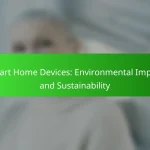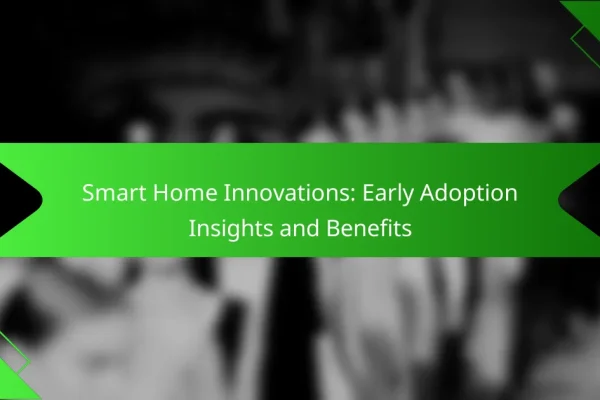What are the key innovations in smart home technology?
Key innovations in smart home technology include advancements in automation, security, and energy efficiency. These innovations enhance convenience, safety, and sustainability in residential settings.
AI-powered home assistants
AI-powered home assistants, such as Amazon Alexa and Google Assistant, serve as central hubs for controlling various smart devices. They use voice recognition and machine learning to understand user commands and automate tasks, making daily routines more efficient.
When choosing an AI assistant, consider compatibility with your existing devices and the range of services offered. Look for features like multi-user support and integration with third-party applications to maximize functionality.
Smart security systems
Smart security systems provide enhanced protection through features like remote monitoring, motion detection, and automated alerts. These systems often include cameras, doorbell sensors, and smart locks that can be controlled via mobile apps.
Investing in a smart security system can significantly improve home safety. Look for systems that offer cloud storage for video footage and ensure they comply with local privacy regulations to protect your data.
Energy-efficient smart appliances
Energy-efficient smart appliances, such as refrigerators, washing machines, and thermostats, optimize energy usage to reduce utility bills. These devices can be programmed or controlled remotely, allowing users to monitor and adjust settings for maximum efficiency.
When selecting smart appliances, check for Energy Star ratings and consider the long-term savings on energy costs. Many appliances can provide usage reports, helping you identify patterns and further reduce consumption.
Home automation platforms
Home automation platforms integrate various smart devices into a cohesive system, allowing for seamless control and automation. Popular platforms include Apple HomeKit, Samsung SmartThings, and Google Home, which support a wide range of devices from different manufacturers.
Choose a platform that aligns with your existing devices and future needs. Look for user-friendly interfaces and robust support for automation routines, such as scheduling and conditional triggers, to enhance your smart home experience.
Smart lighting solutions
Smart lighting solutions enable users to control their home lighting remotely, adjust brightness, and change colors through apps or voice commands. These systems can enhance ambiance and improve energy efficiency by allowing for automated schedules and motion detection.
When implementing smart lighting, consider options like LED bulbs that offer smart features and compatibility with your existing home automation platform. Look for systems that allow for easy integration and customization to suit your lifestyle.
How is smart home technology evolving in urban areas?
Smart home technology is rapidly evolving in urban areas, driven by the need for enhanced convenience, security, and energy efficiency. As cities grow, integrating smart solutions into homes becomes essential for improving the quality of life and optimizing resource use.
Integration with city infrastructure
Smart homes are increasingly being designed to integrate seamlessly with city infrastructure, such as public transportation systems and utilities. This integration allows for real-time data exchange, enabling residents to monitor traffic conditions, access public services, and manage energy consumption more effectively.
For example, smart home devices can communicate with city traffic lights to optimize travel routes, reducing congestion and saving time. This interconnectedness enhances urban living by providing residents with valuable information at their fingertips.
Enhanced connectivity in metropolitan regions
In metropolitan areas, enhanced connectivity is crucial for the functionality of smart home systems. High-speed internet and advanced wireless technologies, such as 5G, facilitate the communication between smart devices and cloud services, ensuring quick response times and reliable performance.
Residents can control their smart home devices remotely through mobile applications, allowing for greater flexibility and convenience. This connectivity also supports the use of smart sensors that monitor environmental conditions, helping to maintain optimal living environments.
Focus on sustainability and energy efficiency
Urban smart homes are increasingly focusing on sustainability and energy efficiency, responding to growing environmental concerns. Smart technologies, such as smart thermostats and energy-efficient appliances, help homeowners reduce their energy consumption and lower utility bills.
For instance, smart thermostats can learn user habits and adjust heating and cooling accordingly, potentially reducing energy use by up to 20%. Additionally, integrating renewable energy sources, like solar panels, with smart home systems can further enhance sustainability efforts in urban environments.
What are the benefits of smart home technology?
Smart home technology offers numerous benefits, including improved convenience, enhanced security, and increased energy efficiency. These advantages make daily living easier and can lead to significant cost savings over time.
Increased convenience and comfort
Smart home devices streamline daily tasks, allowing users to control lighting, temperature, and appliances from their smartphones or through voice commands. For example, smart thermostats can learn your schedule and adjust temperatures automatically, ensuring comfort without manual adjustments.
Additionally, smart home systems can integrate with various devices, creating a cohesive environment. This means you can set scenes for different activities, like movie nights or dinner parties, with just a single command.
Enhanced security features
Smart home technology significantly boosts security through features like smart locks, cameras, and motion sensors. These devices can send real-time alerts to your phone if they detect unusual activity, allowing for immediate action.
Many smart security systems offer remote access, enabling homeowners to monitor their property from anywhere. This capability can deter potential intruders and provide peace of mind, especially when traveling.
Energy savings and efficiency
Implementing smart home technology can lead to substantial energy savings. Smart devices, such as energy-efficient bulbs and smart plugs, can help reduce electricity consumption by allowing users to schedule when devices are on or off.
For instance, smart thermostats can optimize heating and cooling based on occupancy patterns, potentially lowering energy bills by 10-20%. Homeowners should consider investing in Energy Star-rated devices to maximize efficiency and savings.
Remote monitoring and control
Remote monitoring and control are key features of smart home technology, enabling users to manage their homes from anywhere with an internet connection. This includes adjusting thermostats, turning off lights, or checking security cameras.
Many smart home systems offer mobile apps that provide real-time data and notifications, enhancing user engagement. Homeowners should ensure their Wi-Fi network is secure to protect their devices from unauthorized access while enjoying the convenience of remote management.
What are the challenges facing smart home technology?
Smart home technology faces several significant challenges that can hinder its widespread adoption. Key issues include interoperability among devices, data privacy concerns, and high initial investment costs.
Interoperability issues
Interoperability issues arise when smart home devices from different manufacturers cannot communicate effectively with each other. This lack of standardization can lead to a fragmented user experience, where homeowners must manage multiple apps or systems to control their devices.
To mitigate these challenges, consumers should look for devices that support common standards such as Zigbee or Z-Wave. Additionally, platforms like Google Home or Amazon Alexa can help unify control across various brands, making it easier to create a cohesive smart home environment.
Data privacy concerns
Data privacy concerns are paramount in smart home technology, as many devices collect sensitive information about users’ habits and preferences. This data can be vulnerable to breaches, leading to unauthorized access or misuse.
To protect personal information, users should choose devices with strong security features, such as end-to-end encryption. Regularly updating device firmware and being cautious about sharing data with third-party services can also enhance privacy and security.
High initial investment costs
The high initial investment costs of smart home technology can deter potential buyers. While prices vary widely, setting up a comprehensive smart home system can range from several hundred to several thousand dollars, depending on the number and type of devices.
To manage costs, consumers can start with a few essential devices, such as smart bulbs or a smart speaker, and gradually expand their system. Additionally, looking for bundled deals or sales can help reduce the overall expenditure while still enhancing home automation.
How to choose the right smart home devices?
Choosing the right smart home devices involves assessing compatibility, evaluating user feedback, and considering long-term support. These factors ensure that your devices work seamlessly together and continue to function effectively over time.
Assess compatibility with existing systems
Before purchasing smart home devices, check their compatibility with your current systems, such as Wi-Fi networks, smart hubs, or voice assistants. Devices that support common standards like Zigbee or Z-Wave are often more versatile.
For example, if you already have a smart hub, ensure new devices can connect to it. This will prevent issues with integration and functionality, saving you time and money in the long run.
Evaluate user reviews and ratings
User reviews and ratings provide valuable insights into a device’s performance and reliability. Look for products with high ratings and read through both positive and negative feedback to get a balanced view.
Pay attention to comments regarding ease of installation, user interface, and customer support. Devices with consistent praise for these aspects are likely to offer a better overall experience.
Consider long-term support and updates
Long-term support and regular updates are crucial for the longevity of your smart home devices. Check if the manufacturer has a history of providing software updates and customer support.
Devices that receive regular updates not only enhance security but also improve functionality over time. Opt for brands known for their commitment to ongoing support to ensure your investment remains relevant and secure.












